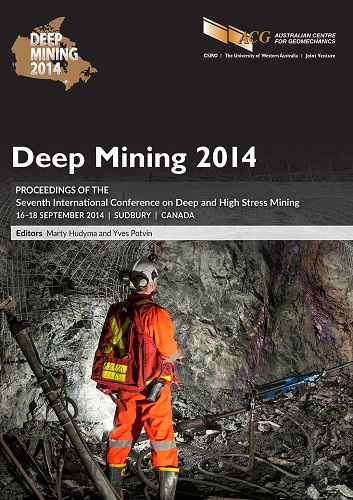Estimation of in situ stress using the memory technique for deep mining

|
Authors: Dight, PM; Tarasov, BG; Hsieh, A; Dyskin, AV |
DOI https://doi.org/10.36487/ACG_rep/1410_42_Dight
Cite As:
Dight, PM, Tarasov, BG, Hsieh, A & Dyskin, AV 2014, 'Estimation of in situ stress using the memory technique for deep mining', in M Hudyma & Y Potvin (eds), Deep Mining 2014: Proceedings of the Seventh International Conference on Deep and High Stress Mining, Australian Centre for Geomechanics, Perth, pp. 601-614, https://doi.org/10.36487/ACG_rep/1410_42_Dight
Abstract:
A series of tests are described in which the in situ stress has been recovered using the rock memory technique, known as deformation rate analysis (DRA), where the samples have been subjected to confinement (30 and 50 MPa). The rock samples comprised Urad Aplite Porphyry and were recovered from oriented core, drilled from a depth of approximately 1,550-1,650 m below surface lower than the current mine development. The oriented core is subsampled to obtain the test samples in six directions. The tests were performed in a sophisticated, very stiff triaxial stress cell. The unconfined compressive strength (UCS) of the rock was approximately 70 MPa. The maximum in situ stress was determined to be approximately 70 MPa. Based on experience the test procedure adopted typically loads the samples to a stress equal to three times the estimated overburden stress. In this case, that would be approximately 120 MPa, which would clearly exceed the UCS and hence the unconfined memory test would not have been applicable. Testing under confinement can increase the measurable stress difference, i.e. 1-3, and thus significantly extend the depth to which this technique can be undertaken when compared with unconfined tests suitable for other memory techniques. In particular, in the tests conducted, the confinement of 30 and 50 MPa raised the strength (1-3) from 70 MPa to between 170-270 MPa. Such an approach has implications for testing rock samples recovered from deep drilling where conventional testing could not reach the expected in situ stress without premature failure of the samples.
References:
Dight, PM & Snyman, LA 2010, ‘Stress measurement for St Barbara Mines Gwalia Deeps project – one of the world's deepest underground haulage mines’, Mining Technology, vol. 119, no. 4, pp. 246-254.
Dight, PM, Tarasov, BG, Hsieh, A & Dyskin, AV 2013, ‘Determining stress memory under confinement’, in T Ito (ed.), Proceedings of the Sixth International Symposium on In-Situ Rock Stress, International Society for Rock Mechanics, Lisbon.
Engelder, T, Plumb, R & Sbar, M 1984, ‘Changes in in situ ultrasonic properties of rock on strain relaxation’, International Journal of Rock Mechanics and Mining Sciences & Geomechanics Abstracts, vol. 21, no. 2, pp. 75-82.
Hsieh, A 2014, ‘In-situ stress reconstruction using rock memory’, PhD thesis, The University of Western Australia Perth.
Nur, A 1971, ‘Effects of stress on velocity anisotropy in rocks with cracks’, Journal of Geophysical Research, vol. 76, no. 8.
Nur, A & Simmons, G 1969, ‘Stress-induced velocity anisotropy in rock: an experimental study’, Journal of Geophysical Research, vol. 74, no. 27.
Plumb, R, Engelder, T & Yale, D 1984, ‘Near surface in situ stress: 3. Correction with microcrack fabric within the New Hampshire granites’, Journal of Geophysical Research, vol. 89, no. B11.
Sayers, CM 1990, ‘Orientation of microcracks formed in rocks during strain relaxation’, International Journal of Rock Mechanics and Mining Sciences & Geomechanics, vol. 27, no. 5.
Yamamoto, K, Kuwahara, Y, Kato, N & Hirasawa, T 1990, ‘Deformation Rate Analysis: A new method for in situ stress estimation from inelastic deformation of rock samples under uni-axial compressions’, Tohoku Geophysics Journal, vol. 33, no. 2,
pp. 127-147.
© Copyright 2025, Australian Centre for Geomechanics (ACG), The University of Western Australia. All rights reserved.
View copyright/legal information
Please direct any queries or error reports to repository-acg@uwa.edu.au
View copyright/legal information
Please direct any queries or error reports to repository-acg@uwa.edu.au